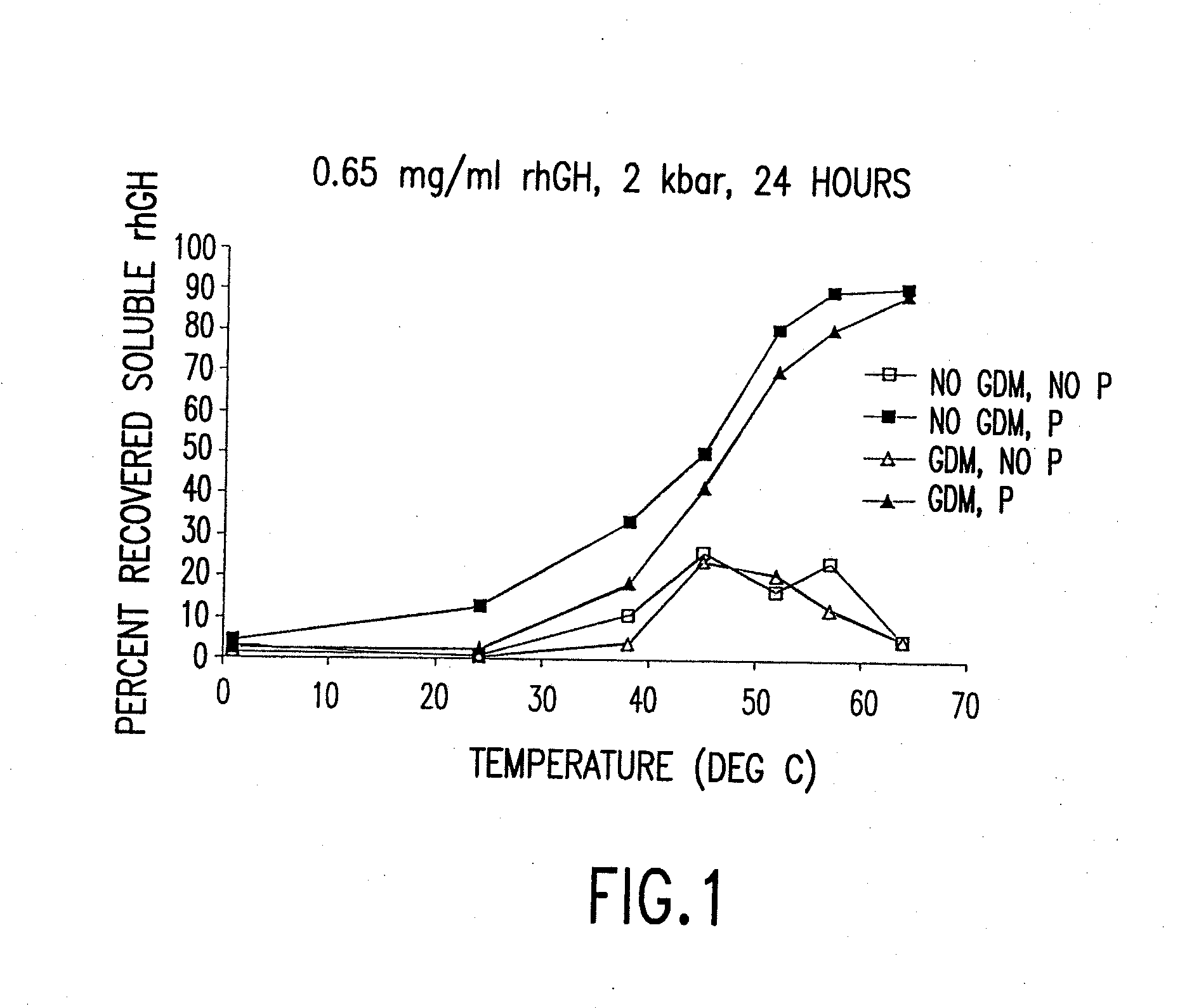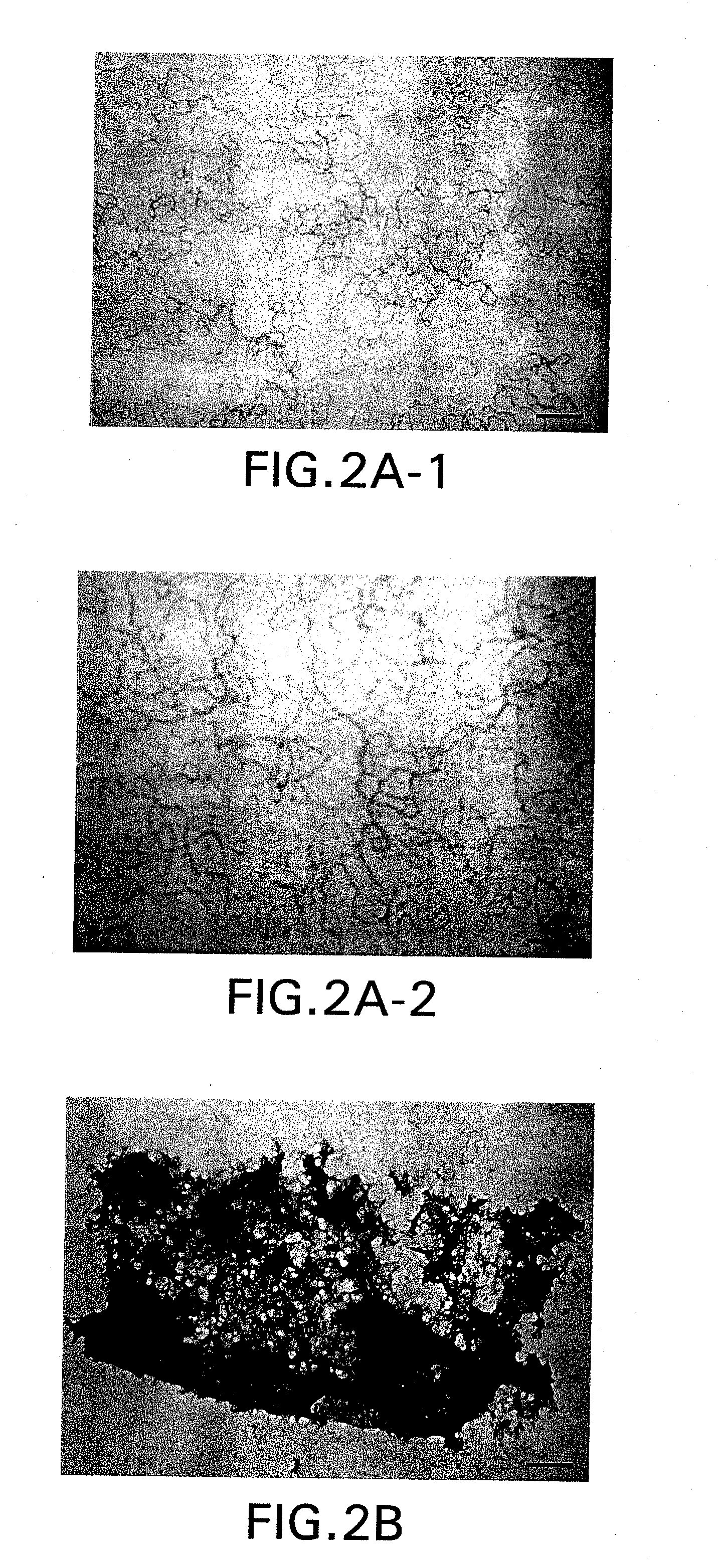Methods for protein refolding
a protein and refolding technology, applied in the field of protein biochemistry, can solve the problems of time-consuming, disaggregation, and almost complete unfolding of proteins, and achieve the effect of reducing the number of proteins
- Summary
- Abstract
- Description
- Claims
- Application Information
AI Technical Summary
Benefits of technology
Problems solved by technology
Method used
Image
Examples
example 1
High Pressure Disaggregation and Refolding
[0173]Procedure 1: High Pressure Protein Disaggregation and Refolding Varying Temperature
[0174]Protein aggregation: Recombinant human growth hormone (rhGH) was suspended in 10 mM sodium citrate buffer (pH 6.0, 1 mM EDTA, 0.1% sodium azide) at a concentration of 1.5 mg / ml. 10 mL of rhGH solution was tumbled end over end in a 15 ml conical falcon tube at 8 rpm for at least 24 hours. Aggregates showing greater structural damage were tumbled under identical conditions with the addition of 0.75M guanidine hydrochloride in the citrate buffer.
[0175]Sample Preparation: One-half the required volume was centrifuged at 13,000 g for 15 minutes to sediment the insoluble aggregates. Supernatant was decanted and replaced with the final volume of buffer (10 mM sodium citrate buffer, pH 6.0, 1 mM EDTA, 0.1% sodium azide). The aggregate pellet was resuspended with an Ultrasonics brand sonicator (50% duty, 1 second pulse cycle). Once resuspended, samples were ...
example 2
High Pressure Refolding of Fibrous and Amorphous Aggregates of rhIFN-γ
Materials and Methods
[0181]Purified recombinant DNA derived rhIFN-γ in 5 mM sodium succinate, pH 5.0 (succinate buffer) was provided by Genentech Inc., stored at 4° C. until use and used without further purification. 40 mM pyridine acetate, pH 5.0 buffer (PyrAc buffer) was used for gas-phase electrophoretic mobility mass analysis (GEMMA). Succinate buffer was used in all other experiments. Protein standards (bovine serum albumin, glucose oxidase, hemoglobin, ubiquitin and thyroglobulin) were purchased from Sigma. All chemicals were of reagent grade or higher and were purchased from Sigma as well.
[0182]Aggregate preparation. Aggregates were prepared by inducing aggregation either by raising the solution temperature to 40° C. or by adding guanidine hydrochloride to the protein solution such that the final guanidine hydrochloride concentration was 0.45 M. The extents of the aggregation reactions were in excess of 95%...
example 3
Lysozyme Refolding
[0220]Pressure was generated using high-pressure nitrogen (40 MPa) connected to a 10-fold hydraulic intensifier (High Pressure Equipment Company, Erie, Pa.). One mg / ml suspensions of lysozyme aggregates in 50 mM Tris (pH 8.0, at 24° C.), varying amounts of GdnHCl, 2 mM DTT and GSSG at the desired final ratio (GSSG:GSH; an optimal ratio was 1:1) were prepared in heat-sealed bulbs of SAMCO® transfer pipettes, sealed within a bag of water, and placed into a to a 2 liter cloverleaf reactor rated to 200 MPa and filled with oil. Samples were slowly pressurized (over 20 minutes) to final desired pressure to minimize pressurization-induced heating. Depressurization was conducted in 20 MPa increments, with each depressurization step requiring approximately 5 minutes. Samples were incubated at each intermediate pressure during depressurization for 15 minutes, yielding an overall depressurization rate of 1 MPa / minute (10 bar / minute). Thermal transients caused by pressure-indu...
PUM
 Login to View More
Login to View More Abstract
Description
Claims
Application Information
 Login to View More
Login to View More - R&D
- Intellectual Property
- Life Sciences
- Materials
- Tech Scout
- Unparalleled Data Quality
- Higher Quality Content
- 60% Fewer Hallucinations
Browse by: Latest US Patents, China's latest patents, Technical Efficacy Thesaurus, Application Domain, Technology Topic, Popular Technical Reports.
© 2025 PatSnap. All rights reserved.Legal|Privacy policy|Modern Slavery Act Transparency Statement|Sitemap|About US| Contact US: help@patsnap.com



